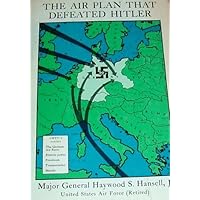
Average Reviews:

(More customer reviews)In The Air Plan That Defeated Hitler, Hansell describes the evolution of the strategic bombing campaign against Germany in WW II. Recounting from first-hand knowledge, Hansell begins his book with a brief exploration of the Army Air Corps as a "service looking for an independent mission", the strategic thought coming out of the Air Corps Tactical School, and the bomber versus fighter controversy. Once this ground work is laid, the author launches into an exploration of the various strategic bombing plans developed throughout the war against Germany. Starting with Air War Plans Division 1 (AWPD-1)and continuing through AWPD-42 and the Combined Bomber Offensive (CBO), the author does an excellent job of describing what was in each plan with special emphasis on targeting and priorities. The major thrust of his discussion lies in the contrast and comparison of target selection from plan to plan. With both AWPD plans, an "intermediate objective", though stated as essential to the accomplishment of each plan, was the destruction of the German Air Force. This reviewer was then left with the thought that truly the most important objective was destruction of the Luftwaffe although if the plan was written that way, it would detract from the strategic mindset of the planners. Despite all of the changes in targeting priorities from plan to plan, the author does not conduct a very complete analysis of why these changes took place. For the most part, he explains the what of each plan, but none of the why. Perhaps he has no personal knowledge of why the changes were made, however some in-depth research would offer the reader a more complete understanding. Also, this reviewer felt the author was too close to his subject to be objective and impartial; something like the parent who refuses to believe his baby may be ugly. One gets the feeling that the author's stance is that strategic bombing will work (the bomber will always get through), no matter what, regardless of the fact it had never been accomplished and was based wholly on theory. Simply because those at the Air Corps Tactical School propounded the virtues of strategic bombing doctrine did not necessarily mean it was correct. One gets the feeling that if only those who developed the CBO had followed both AWPD plans (which the author helped develop) then the war would have been shortened and lives saved, though Hansell presents no analysis to prove his point. Despite the lack of depth and blind adherence to strategic bombing doctrine, I did find the book useful for filling in some gaps of exactly what the different bombing plans contained. It was also interesting to see how plans changed depending on who was commanding and who was making the decisions. Lastly, the use of bombers for close air support, interdiction, and preparation of the battlefield for the D-Day invasion should not be viewed by Hansell as the misappropriation of air power and aircraft. It merely reflects the political and military priorities of the time.
Click Here to see more reviews about: Air Plan That Defeated Hitler (Flights : Its First Seventy-Five Years Series)

0 comments:
Post a Comment